A contact cleaner’s job is to quickly remove insulative contamination as quickly as possible, which can avoid a lot of wiping and scrubbing. Contact cleaners are usually packaged in pressurized aerosol cans to provide a forceful spray that creates agitation and reaches into all the crevices of the connectors.
Related types of products include electrical cleaners, switch cleaners, and specific for automotive repair, battery terminal cleaner.
WHY USE A CONTACT CLEANER?
Any contamination in the contact area of an electrical device, like dust, dirt, grease, and oxidation, can increase electrical resistance and possibly lead to connectivity issues. That means the current flow is potentially reduced or interrupted, affecting the performance of the device and potentially leading to safety hazards. Contact areas with high resistance could become hot or conductive contamination could create a short.
There are a number of options available and trade-offs to consider when shopping for a contact cleaner. While a low price can be attractive, other factors can have a big impact on performance and safety…
Flammability
Contact cleaners often contain alcohols and hydrocarbon solvents, which are very flammable. They are generally economical effective cleaners, but can pose a safety hazard without proper ventilation, especially if there are open flames, sparks (e.g. welding process), or hot surfaces nearby.
Nonflammable contact cleaners can avoid these safety issues, but usually at a premium price. Watch out for nonflammable cleaners that contain toxic materials such as perchloroethylene, trichloroethylene or n-propyl bromide (see details later in this paper).
The most common method of identifying the flammability rating of an aerosol contact cleaner is the GHS (Global Harmonized System) flammable pictogram (see diamond symbol above). Unless an aerosol contact cleaner is able to pass a very stringent test, it must have the flammable pictogram on the label.
Some contact cleaners and other industrial cleaners have “High Flash” or “HF” in the name. High flashpoint solvents still support combustion, but the vapors will not combust in normal ambient temperatures below 140°F/60°C.
To measure the flash point of a solvent, it is heated from room temperature to boiling point, and at the same time, a sparker or ignition source is used to try to light the vapors. If the vapors light, the temperature of the heated solvent is recorded at time, providing a flash point.
High flash point contact cleaners are generally chosen because that have a relatively low cost and considered safer to use in normal operating conditions compared to highly flammable solvents.
Choosing a high flashpoint solvent can slow down your process, because they often contain terpene-based solvents and/or citrus-based d-limonene solvents. These have extremely slow evaporation, so while an alcohol-based solvent might fully evaporate out of a connector in minutes, a high flash solvent could take hours.
Dielectric Strength
If you plan to clean contacts with the power is on, or may turn it on before the solvent has fully evaporated, look for a cleaner with as high of dielectric strength as possible. Always know the amperage and voltage of the circuits you are trying to clean before spraying anything onto the circuits, and evaluate the suitability of any cleaner in your application. The higher the number the better, and you want to avoid spraying energized contacts with anything below 30 kV (30,000 volts).
Dielectric strength is the maximum electric field that the material can withstand before its insulating properties break down. The lower the dielectric strength, the more likely it will breakdown and allow electricity to flow through it, creating a short circuit and/or a significant safety issue.
As soon as there is enough free electricity it will immediately or, in a nanosecond, discharge through the insulating material. If it doesn’t discharge through, it’s going to severely degrade it to the point it is of no insulating use.
Plastic / rubber compatibility
While the contact surfaces of connectors are metal, they are often housed in plastic, in addition to rubber gaskets. A solvent cleaner that is incompatible can craze (create small cracks), embrittle, or soften plastic, and swell, shrink or even dissolve seals. When evaluating a new contact cleaner, it should always be tested before use.
Rigid plastics like ABS, polycarbonate (trade name Lexan), and acrylic materials like Plexiglass can be very sensitive to harsh solvents like toluene, xylene, and acetone. Alcohol and hydrocarbon based solvents tend to be better on sensitive plastics.
Rubber, silicone or other seals or gaskets made of elastomeric (soft) materials can have a tendency to swell or shrink with exposure to harsh solvents. After the solvent flashes off, they may spring back to their original dimensions, or be permanently changed, impacting the effectiveness of the seal. Polyester or Teflon based gasketing materials are less prone to this type of damage from harsh solvents.
Toxicity
N-Propyl Bromide (nPB), Trichloroethylene (TCE) and Perchloroethylene (Perc) are toxic solvents often used in nonflammable contact cleaners. There are cited examples where workers suffered major health effects when exposed to high levels of these chemicals including headaches, dizziness, and even loss of full body control. Other studies have shown a possible link to reproductive problems and cancer.
These risks have prompted maintenance facilities to rethink their solvent choices, especially with manual cleaning when exposure tends to be higher than the more automated cleaning processes. Contact cleaning, by its very nature, is very hands-on, so close control of chemical exposure is generally very challenging. The best option is to avoid the most toxic solvents, even if they are legal and readily available.


The quickest and easiest method of identifying a potential concern is the GHS (Global Harmonized System) pictograms (see diamond symbol above). If you see the chronic toxicity pictogram (diamond containing person with exploding chest), that means the product contains something that can cause long-term effects. That doesn’t necessarily mean a carcinogen, but it should prompt you to look closely at the Safety Data Sheet (SDS).
The acute toxicity pictogram (diamond containing skull and cross-bones) means the product can have a short-term health impact. Again, check the SDS carefully if you see this symbol. You may need to take extraordinary measures to reduce personal exposure, or if that is unrealistic for your application, avoid the product altogether.
No Techspray contact cleaner contains toxic solvents like nPB, TCE, and Perc. While you still should pay attention to label warnings, SDS, and wear adequate personal protection equipment (PPE), the requirements will not be as over-the-top to stay within a safe range of exposure.
For more information on this topic, check out the video webinar “Replacing n-Propyl Bromide (nPB): What You DON'T Know CAN Hurt You” and the article “EPA Considers 1-Bromopropane (n-Propyl Bromide, nPB) an ‘Unacceptable Risk’ for Degreasing”.
Environmental issues
In the past, ozone depletion was a concern with contact cleaners containing chlorofluorocarbons (CFCs) like the Freon and hydrochlorofluorocarbons (HCFCs) like AK-225. Since those solvents are no longer available on the commercial market in North America, concerns have turned to volatile organic compounds (VOCs), solvents that add to smog, or solvents with high global warming potential (GWP). Some state (e.g. CARB or California Air Review Board), municipal, and even industry-specific regulations restrict the use of high VOC or high GWP materials.
To complicate things, VOC is defined and measured differently by various agencies. A contact cleaner might be considered low-VOC according to the standard EPA (Environmental Protection Agency) definition, but may be high according to CARB.
How to Remove Rust
Solvent-based contact cleaners are not generally effective at removing rust and other forms of oxidation.
To remove oxidation or rust, a brass or steel brush is the most common method of scrubbing off oxidation. With this method, take care to avoid damaging contacts and other components. For sensitive contacts nylon is also used.
To remove rust in tight areas of electrical connectors and switches, a mild acid like vinegar can be used, and other agents are offered for battery terminal cleaning, such as baking soda. Regardless of the cleaning material, care should be taken to rinse it off. A cleaner strong enough to remove rust could continue to work on unintended metal surfaces.
For more information on Techspray contact cleaners, go to www.techspray.com or call 800-858-4043.






